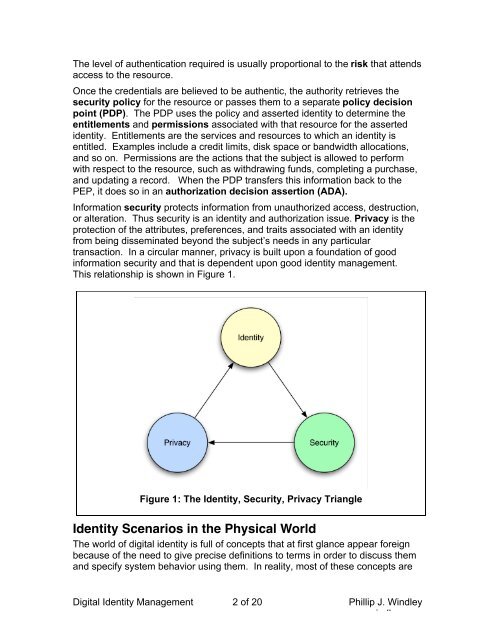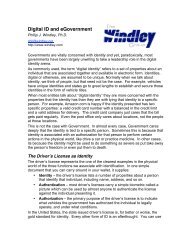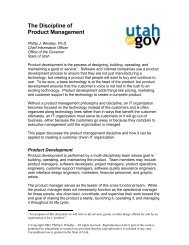The level of authentication required is usually proportional to the risk that attendsaccess to the resource.Once the credentials are believed to be authentic, the authority retrieves thesecurity policy for the resource or passes them to a separate policy decisionpoint (PDP). The PDP uses the policy and asserted identity to determine theentitlements and permissions associated with that resource for the assertedidentity. Entitlements are the services and resources to which an identity isentitled. Examples include a credit limits, disk space or bandwidth allocations,and so on. Permissions are the actions that the subject is allowed to performwith respect to the resource, such as withdrawing funds, completing a purchase,and updating a record. When the PDP transfers this information back to thePEP, it does so in an authorization decision assertion (ADA).Information security protects information from unauthorized access, destruction,or alteration. Thus security is an identity and authorization issue. Privacy is theprotection of the attributes, preferences, and traits associated with an identityfrom being disseminated beyond the subject’s needs in any particulartransaction. In a circular manner, privacy is built upon a foundation of goodinformation security and that is dependent upon good identity management.This relationship is shown in Figure 1.Figure 1: The <strong>Identity</strong>, Security, Privacy Triangle<strong>Identity</strong> Scenarios in the Physical WorldThe world of digital identity is full of concepts that at first glance appear foreignbecause of the need to give precise definitions to terms in order to discuss themand specify system behavior using them. In reality, most of these concepts are<strong>Digital</strong> <strong>Identity</strong> <strong>Management</strong> 2 of 20 <strong>Phil</strong>lip J. Windleywww.windley.com
perfectly understandable given our everyday experience in personal andcommercial transactions in the physical world.For example, a driver’s license is a credential that asserts that a person hascertain attributes and traits. The license contains authorization to perform certaintasks, specifically to drive a car. When a person (i.e. the subject) wants to buybeer (i.e. perform an action on a resource), the clerk (i.e. security authority)examines the license to see if it looks real (i.e. determines the validity of thecredential) and uses the picture (i.e. embedded biometric device) to see if theperson presenting the license is the same person who owns it (i.e. authenticatesthe credential). Once certain that the license is authentic, the clerk, reads thebirth date (i.e. attribute) from the license and determines whether the person isover 21 (i.e. consults a security policy determined by the state and makes apolicy decision about permissions associated with the identity).Now, suppose the person pays with a credit card. The credit card (a separateidentity credential) is presented to the clerk. The clerk just saw the driver’slicense and so can establish the validity of this credential based on the first. Theclerk, acting as the policy enforcement point, runs the card through the POSterminal which transmits identity attributes from the card (the credit card numberand expiration date) along with the resource to be accessed (credit in the amountnecessary to buy the beer) to the bank which acts as the policy decision pointand determine whether or not the subject is entitled to credit in the necessaryamount. The clerk receives the credit authorization (authorization decisionassertion) and completes the transaction.The Business Context of <strong>Identity</strong>In addition to being able to identify customers so that they can sell them services,businesses have an increasing need to identify employees, systems, resources,and services in a systematic way to create business agility and ensure thesecurity of business assets.In the past people have thought of security as an edge game. Given a firewalland access control to the network, a business can be made reasonably secure.However, the economic shifts spoken of above have driven the need to integratesystems, not only internally, but with trading partners and customers as well.This has been fueled by XML and the creation of standards for exchanging dataand the increasing trend to decentralized computing embodied in Web services.This trend has a huge ramification for business security: we can no longer treatthe edges of the network as a secure perimeter.When integration is driven by business needs, security policies need to talk aboutdocuments, data, actions, people, and corporations instead of machines andnetworks. This security model is infinitely more complex than the old "secureperimeter" model. But even if you define your policy, how do you ensure that it isproperly implemented across dozens or even hundreds of systems and at thesame time control access to resources as granular as fields of a database orparagraphs of a document? The answer lies in digital identity management.<strong>Digital</strong> <strong>Identity</strong> <strong>Management</strong> 3 of 20 <strong>Phil</strong>lip J. Windleywww.windley.com






